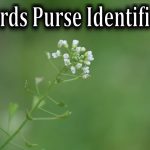The leaves are a dark green color and can grow up to a foot long. The stem of the plant is very stout and covered in short, stiff hairs. The flowers of the plant are a purple color and form in clusters. The fruits of the plant are burrs that have hooked spines that stick to clothing and fur.
Common burdock or Arctium minus is a wild edible and medicinal plant that can be found in fields. It is important to know how to identify it before using it for medicinal or culinary purposes. The leaves of common burdock are large, broad, and ovate with rippled margins. At the bottom, the leaves will grow in a basal rosette with very fine teeth along the margins, while at the top the margins are smooth and the leaves become much smaller, though maintaining their broad and ovate shape. The leaves are a dark green color and can grow up to a foot long. The stem of the plant is very stout and covered in short, stiff hairs. The flowers of the plant are a purple color and form in clusters. The fruits of the plant are burrs that have hooked spines that stick to clothing and fur.
The taproot of common burdock is the part that is used most often for medicinal and culinary purposes. It can be eaten raw or cooked and has a sweet, earthy flavor. It is rich in vitamins and minerals, as well as antioxidants. It can be used to treat skin conditions, digestive issues, and inflammation. The leaves can be eaten raw or cooked and have a bitter flavor. They are high in vitamins A, C, and K, as well as calcium, iron, and magnesium. The seeds can be ground into a powder and used as a flour substitute or added to soups and stews for extra nutrition.
Common burdock is an easy plant to identify due to its large, broad leaves with rippled margins, stout stem covered in short, stiff hairs, purple flowers in clusters, and burrs with hooked spines. Knowing how to identify this plant is important before using it for medicinal or culinary purposes. Once identified, the taproot, leaves, and seeds can all be used for their various health benefits.



GIPHY App Key not set. Please check settings